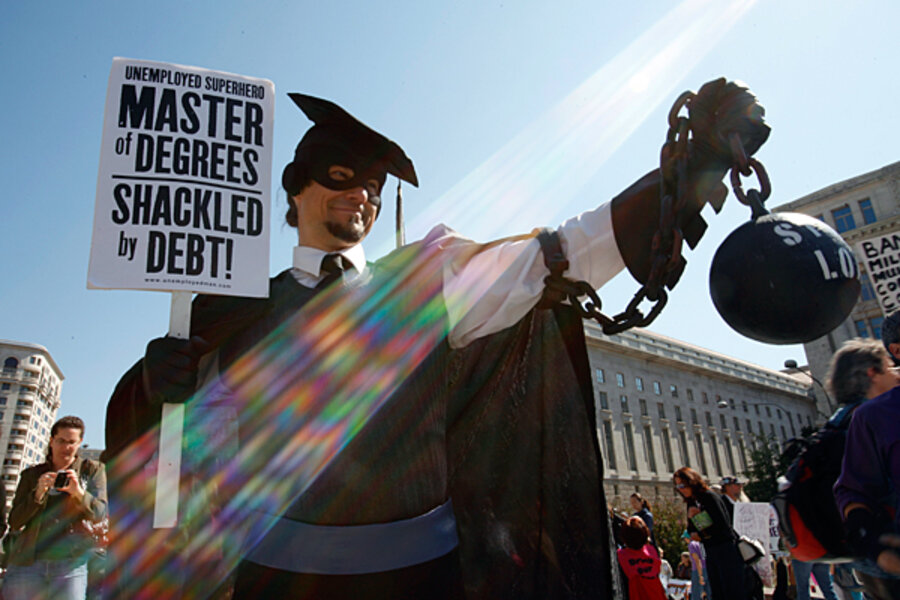Student loans: As debts hit $1 trillion mark, protesters plan Occupy-type events
Loading...
| Los Angeles
President Obama’s college-campus swing urging action on student-loan debt is neatly tied to Wednesday’s 1TDay, named for the moment that student debt is expected to hit the $1 trillion mark. Protesters against this debt load, which they deem “beyond tolerable,” are gathering in Manhattan’s Union Square with concurrent actions in some 20 cities from Amherst, Mass., to Santa Cruz, Calif.
“This is the first step in a political process,” says lead organizer Andrew Ross, professor of social and cultural analysis at New York University. His involvement stems from a growing awareness of his own students’ burden, he says, pointing to the fact that NYU student debt is some 40 percent above the national average.
“I’ve been aware that my own salary depends in part on students racking up an enormous debt that takes decades to pay off, if they even can,” he says.
The 1TDay group, which is in solidarity with the Occupy movement, has four key proposals:
• The federal government should cover all higher-education costs, at both two- and four-year colleges.
• If loans are to be made at all, they should be with zero interest.
• All colleges should open their books for total transparency.
• There should be a one-time debt forgiveness, or “jubilee.”
Paying for an education “is not the equivalent of buying a flat-screen TV,” he says, since an education forwards the interests of both individuals and the nation as a whole. “The entire economy has an interest in a well-educated population,” he says, adding that families ought to be able to assess where colleges are spending tuition money.
As for the jubilee, says Professor Ross, “debts are rewritten and written off on Wall Street all the time, but when it comes to little people, they are not allowed to renegotiate the debt.”
While radical shifts may not be realistic, even sober-minded financial observers suggest some changes may be in order. “I don’t think we are headed for a total amnesty,” says Mitchell Weiss, adjunct professor in economics and business at the University of Hartford in Connecticut. The law, he says, currently trims the time for most potential student indebtedness to 20 years, and “I don’t see us cutting the time to 10 years” (as proposed legislation calls for).
However, he thinks it’s quite possible to hold the interest rate for government student loans at 3.4 percent. The rate is set to double in July unless Congress acts.
It may help that this particular issue is one that Mr. Obama – and now GOP hopeful Mitt Romney – are campaigning on.
On Wednesday in Manhattan, street performers will enact mock trials of bankers, says Ross, who will be playing one of the lenders in a skit. “Once the debtors are released, I’m not sure what our fates will be,” he says with a laugh.
Other plans are also afoot for Wednesday. Groups such as Occupy Student Debt and a coalition pushing to pass the Student Loan Forgiveness Act of 2012 (HR 4170) plan to use the day to raise awareness, says Robert Applebaum, a lawyer behind the website www.hr4170.com, which officially launches Wednesday.
Mr. Applebaum’s personal stake in the debate is high – some $88,000 in loans, mostly from law school, he says. As he notes on the site, “In 2010, total outstanding student loan debt exceeded total outstanding credit card debt in America for the first time ever.”
Applebaum plans to hand-deliver to Congress a petition urging passage of HR 4170 as soon as he acquires 1 million signatures, which he says “should be soon.” (He now has more than 900,000.) The law’s key item: reducing the period of a student’s total indebtedness to 10 years.
Student debt affects everyone, says fellow activist Kyle McCarthy, who helped launch occupystudentdebt.com last fall and who also has some $80,000 in loans. “This debt is dragging down the entire economy,” he says, because people cannot move forward with their lives. They can’t buy houses or cars, he says, adding, “I have a friend who cannot marry because she defaulted on a student loan and her partner would inherit her credit, which has now been ruined.”







